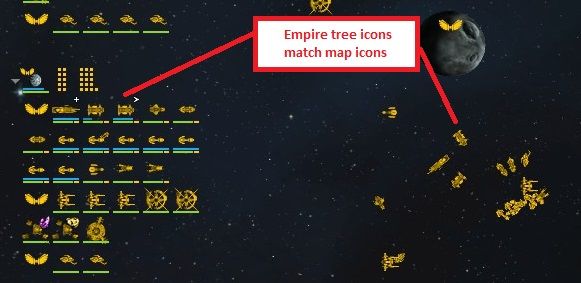I just got Sins: Rebellion on Steam and now I can understand why Ashes has an Empire tree. To make the Ashes empire tree usable requires significant improvements from its current state in 0.71. I don't want to diminish this terrific effort by ASADDF, so I'm just going to talk about why I think the Empire tree in Sins works well, and how it can work better in Ashes.
1. Icons in the tree match the icons on the map. I know Ashes doesn't have icons on the map, and perhaps that is why the icons in the empire tree are currently of less value.

I am NOT advocating icons be added to the map for Ashes. I am advocating a designer rework of the Ashes unit icons so it is clear at a glance which ones are brutes, archers, Apollos, etc. I'm not a designer so I don't know how best to do this, but I bet someone at Stardock is smart enough to figure it out. For example, I'd bet fewer than 1/10 founders can tell me instantly what unit is represented by this icon:

2. Icons are grouped so that the same units are displayed side-by-side, allowing quick estimation of unit count. Using a number instead (as ASADDF recommended) is also possible, though you do potentially lose some useful info like health.

3. Each planet shows its own distinct list of unit icons so you know the precise size, strength, and composition of your forces in that particular area.

This works in Sins because the battle areas are logically separated. In Ashes regions have borders, but local units often straddle the borders. I have an idea for this at the end.
4. You can see the local buildings and resources. This can help you quickly estimate the local defensive capabilities, as well as production and economy value of a particular area.

5. You get perfect knowledge of enemy forces at the planet, showing the size, strength, and composition of the local enemy force. From this you can 1. estimate whether you have appropriate local structures and units to win the battle, 2. determine the required counter forces you need to counter the local enemy forces.

----
Issue 1: One problem that could be addressed is the overloading of control groups. In Sins control groups are equivalent to a group of forces. But in Ashes control groups are also essentially physical locations. Ctrl-1 is my North defensive group, Ctrl-2 is my South push group. As the location of these control groups changes, you gain the context of where those units are now, but you lose context of where those units used to be. Therefore in the empire tree you lose the context of location, such as forward bases. In Sins, you always know the context of Planets because they are in the Empire tree.
Issue 2: For Ashes, the main issues with 3, 4, and 5 above is that you do not have distinct battle zones like you do in Sins. Furthermore for 5, your knowledge of enemy forces is restricted by line-of-sight.
The solution I recommend, which is not fully fleshed out, is user-definable sectors. This idea is inspired by Districts in Cities: Skylines - https://www.youtube.com/watch?v=K6Kw6302m9k (linking this video for content purposes only, not view boosting). With users able to define sectors the empire tree can display "local" forces and structures that exist within the sectors, both yours and those of the enemy's for which you have line-of-site. A less ambitious option would be for the sector borders to be built into the map design and not user-definable. Sectors would not have to follow region borders, but could instead be logical divisions of the terrain and gameplay progression. As long as the sectors are not too big, the units and buildings inside could be considered "local", and displayed under the sector in the empire tree.
Here is how you might draw out the sectors for one of your existing maps (obviously this is not how it would look to the user). For each sector where you have units, there would be a node in the empire tree displaying units, buildings, etc.


